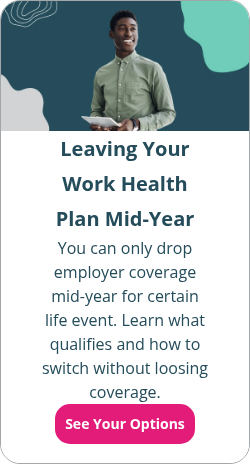Guide to mid-year plan changes
By Elizabeth Walker on August 12, 2025 at 11:00 AM
You're not locked into your health insurance plan forever. However, there are rules for mid-year changes that vary depending on whether you're an employer or an employee and the type of plan you have.
Employers can usually make plan changes anytime, even though they face complex restrictions and potential penalties for doing so. Employees have more flexibility in what they can change, but can only do so during specific enrollment times.
In this article, we'll guide employers and employees through their options for making mid-year changes to their health insurance policies.
In this blog post, you'll learn:
- The requirements for making changes to your health insurance outside of the plan’s enrollment period.
- What counts as a qualifying life event.
- What kind of changes you can make to your plan mid-year.
Can I change my health insurance plan mid-year?
Your ability to change your health insurance plan mid-year depends on whether you're an employer or an employee. Let's explore scenarios for both groups below.
Employers
As an employer, you'll generally make changes to your health plan that take effect at the start of a plan year, giving your employees time to consider their options during the plan’s enrollment period if they don't want to enroll in your group coverage. However, you can typically make changes to your plan at any point during the year.
While changing your organization's health insurance policy may seem like a good idea in some cases, changing your employer-sponsored plan could negatively impact employee participation. So, check your current plan document for any limitations or penalties.
Employees
If employees have an employer-sponsored group plan, they may be able to switch from one plan option to another or cancel their plan mid-year if the following circumstances apply:
- The employee pays for their insurance premium with post-tax dollars.
- Their employer offers multiple group plan options and has designed their plan to allow for mid-year changes.
If an employee pays for their insurance premium with pre-tax dollars, they can only change their plan under specific circumstances.
If employees have individual health insurance coverage and want to switch health plans or make changes to their current plan, they only have two periods to do so—during Open Enrollment or a special enrollment period.
Open Enrollment runs from November 1 to January 15, but the exact dates vary depending on your state. During this time, employees can renew their existing individual plans or search for other coverage options.
Depending on when enrollment in an individual plan occurs, health insurance coverage usually begins on January 1 or February 1. In most states, the normal deadline is December 15 if you want your coverage to start on January 1.
Employees can make as many health insurance plan selections and changes as they like during the Open Enrollment, as long as they finalize their choice by the end of the period. Employees can only make changes to individual plans once the period is over if they have a qualifying life event triggering a special enrollment period.
What are the requirements for making changes outside of the open enrollment period?
Usually, you can only make changes to your policy during the benefit’s enrollment. However, there are a few instances where you can make mid-year changes, provided you meet specific requirements.
Employers
Even though employers can change their current health insurance coverage at any time, they must follow specific requirements to stay in compliance and avoid penalties if they do so outside of their plan's open enrollment.
Employers must consider the three requirements below when making mid-year plan changes:
- ERISA plan documents: ERISA summary plan descriptions and plan documents are legal documents containing relevant health plan information. If an employer makes plan changes, they must create and distribute an ERISA summary of material modification document to employees within 210 days after the plan year containing the change ends.
- Affordable Care Act (ACA) requirements: The ACA and ERISA require employers to give their employees 60 days' advance notice of plan changes before implementing them.
- Enrollment changes: When an employee's health plan costs change mid-year, employers must give the employees the right to change their plans, creating a mini-open enrollment for the employer's affected employees.
- Employers should notify any relevant health insurance companies so they can approve and allow mid-year changes for employees during the mini-open enrollment period.
Employees
Employees with a group plan can only make changes to or cancel their plan if they experience qualifying “change in election” events. We'll cover these in the next section.
Outside of Open Enrollment, employees with health insurance marketplace plans can only make changes during a special enrollment period if they meet specific eligibility requirements. A special enrollment period can occur at any point during the year and applies only to those who have experienced a major life event.
Several common events qualify individuals for a special enrollment period, including:
- Getting married, divorced, or legally separated
- Giving birth or adopting a child
- Beginning, ending, or losing employment
- Loss of eligibility criteria, such as turning 26 and losing your parents' coverage
- A death in the family
- Moving to a new insurance rating area
- Other qualifying events1
Generally, employees have 60 days following their qualifying life event to modify or purchase a health plan. Much like Open Enrollment, a special enrollment period enables employees to explore and evaluate options, either by consulting an individual health insurance broker or visiting state or federal health insurance marketplaces. Occasionally, insurers may ask for verification of the qualifying life event before allowing new enrollment.
What kinds of changes can I make to my plan mid-year?
You may want or need to make changes to your plan for various reasons. But, acceptable reasons will vary depending on whether you're an employer or an employee.
Employers
If an employer is considering changes to its group policy due to a reason like rising medical care costs, there are a few ways it can modify its plan.
The following are changes employers can make mid-year without penalty:
- Change in a current health plan: Employers may consider switching to a cheaper policy, like a high-deductible health plan (HDHP), to help them and their employees save money on their monthly premiums.
- Many employers also consider switching plans if an insurer adjusts their employees' covered services due to a contract dispute or cancellation request between the insurance and a provider.
- Employee contribution changes: Employers looking to make contribution changes to their plan should review their liability under the ACA's employer shared responsibility rules and confirm their new contributions continue to satisfy the carrier's minimum participation requirements.
- They should also determine if their plan allows employees to change their benefit elections due to mid-year contribution changes.
- Waiting period: Employers can add a waiting period to their employees' health plans mid-year. However, the ACA prohibits waiting periods of more than 90 days.
Employees
The IRS provides specific instances when employees can make mid-year changes to their health coverage. For example, employees can make mid-year plan changes if they have a qualified life status change that would affect their health insurance policy.
Individuals must update their insurance provider about these changes, which may impact their eligibility, health insurance options, and monthly premium costs.
Qualified life changes and eligible events include:
- Change in legal marital status
- Change in the number of dependents
- Death of spouse
- Change in dependent status, such as a dependent child losing coverage under another plan
- Change in employment status
- Loss of eligibility criteria
- Loss of coverage
- A dependent called to military service
- Change in residence
- Significant change in household income
- Entitlement to Medicare or Medicaid
- Significant cost changes in coverage
- Health Insurance Portability and Accountability Act (HIPAA) special enrollment rights
Employers aren't required to allow employees to make mid-year election changes except if they are making changes under HIPAA special enrollment rights. For clarity, employers should include in their plan documents and summary plan descriptions which special circumstances entitle employees to make mid-year election changes.
How employers can use an integrated HRA to provide their employees more coverage mid-year
In some cases, employers make mid-year plan changes to save money on their group policy. However, this can leave employees liable for covering a greater share of their medical costs. To combat this scenario, adding a health reimbursement arrangement (HRA) to your health benefit is worth considering.
While some HRAs act as a stand-alone health benefit, an integrated HRA, also known as a group coverage HRA (GCHRA), pairs with your existing job-based plan and provides more comprehensive health coverage to your employees.
Integrated HRAs work with traditional employer health plans, like group health insurance, to reimburse employees tax-free for qualified medical expenses their plan doesn't fully cover, such as deductibles, coinsurance, and other out-of-pocket costs. Only employees enrolled in your employer-sponsored health plan can participate in the HRA.
With integrated HRAs, employers set a monthly allowance that works for their budget. This allowance can be as large or small as the employer chooses.
Unlike a health savings account (HSA), HRAs are not pre-funded accounts. The employer only pays out when employees submit medical costs for reimbursement. Additionally, unused allowance amounts stay with the employer if an employee leaves the company.
The great thing about integrated HRAs is that employers can sign up for one at any point during the year without an enrollment period. Integrated HRAs also work with any group health plan, so you can choose the group policy that works best for your team.
Employers can simply implement an integrated HRA to supplement their plan and provide their employees with tax-free reimbursements for their medical bills.
How employers can use an ICHRA to provide their employees with individual coverage mid-year
Another HRA worth considering is the individual coverage HRA (ICHRA). Unlike the integrated HRA, the ICHRA is a stand-alone HRA that works in place of a traditional group health plan. Employers can cancel their group health insurance policies and switch to ICHRAs mid-year.
The ICHRA is a cost-effective solution since it allows employers to reimburse employees for their individual health insurance premiums instead of buying a group plan for the entire workforce. This saves employers money since individual premiums are often cheaper.
When employers offer an ICHRA to their employees, it triggers a 60-day special enrollment period since they're offering new health coverage. From there, employees can pick the health plans that work best for them.
Conclusion
Choosing a health insurance policy is a big decision for employers and employees. If you're an employer or employee who wants to make changes to your health insurance policy, it's essential to understand the guidelines you need to follow.
If you're an employer looking to improve your employee benefits package, implementing an integrated HRA at your organization is a great option. With an integrated HRA, you can offer your employees a more personalized health benefit to cover their medical care without changing your current group health coverage.
This article was originally published on May 11, 2022. It was last updated on August 12, 2025.
1.https://www.healthcare.gov/coverage-outside-open-enrollment/special-enrollment-period/
Check out more resources
See these related articles

Special enrollment periods (SEPs) and the QSEHRA
Learn how special enrollment periods (SEPs) work with a QSEHRA. Understand eligibility rules and how employees can enroll in health coverage mid-year.

Why do health insurance premiums increase?
Learn why health insurance premiums increase. Discover the factors behind rising costs and what to consider if your health insurance went up.

Guide to premium tax credits for health insurance
See how premium tax credits can lower health insurance costs. Our guide provides the information you need to navigate this important aspect of healthcare.



